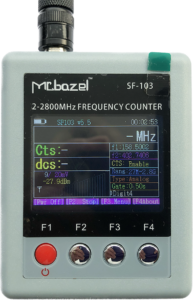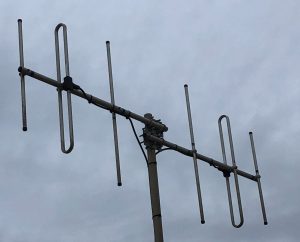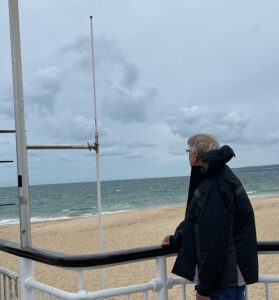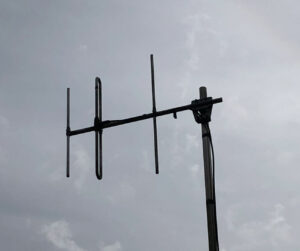Mcbazel Surecom SF-103 Handheld 2MHz to 2.8GHz Walkie Talkie 2-Way Radio Frequency Counter… that’s what it was advertised as and it’s quite a mouthful! You can discover the operating frequency of nearby handheld radios, which is handy if you want to listen in to conversations… or even join in! It will also give you the CTCSS tone or DCS value being used. You can also do a sweep around your house to check for radio bugs. Not really necessary… but you never know!
29/6/2023:
The unit has arrived and I’m impressed. Initial test are encouraging. There’s a video further down the page. I’m hoping to get out and about with the fx counter before long to see what frequencies I can discover. If you’re chatting on your handheld as you see some suspicious looking character lurking nearby, it’s probably me! Seriously, this nice little gadget will be useful for all sorts of things in the shack. It will certainly help when trying to program a Baofeng handheld radio, especially for repeater use. Is the CTCSS tone switched on? Is it the correct frequency tone? Have I chosen the correct DCS value?
I can discover. If you’re chatting on your handheld as you see some suspicious looking character lurking nearby, it’s probably me! Seriously, this nice little gadget will be useful for all sorts of things in the shack. It will certainly help when trying to program a Baofeng handheld radio, especially for repeater use. Is the CTCSS tone switched on? Is it the correct frequency tone? Have I chosen the correct DCS value?
I’ll be updating this page once I’ve had time to use the frequency counter out in the field. There are several places that I visit regularly where there are handheld radios in use. I shall be noting frequencies and squelch tones! Click on the photo to see a larger image.
Specifications:
Frequency range: 2MHz-2800MHz
CTCSS/DCS decoder (must be between 132-173/200-260MHz/400-519MHz).
DMR radio frequency digital mode.
TCxO (X’tal oscillator with temperature compensation) with 2 ~ 2.5 ppm.
Frequency: 0.2 to 0.5 seconds (CTCSS / CDCSS > 0.5 to 1 second)
240 x 320 TFT colour display, horizontal LCD.
Built-in lithium-ion battery.
Net weight:113g
4-button operation.
Automatic shut-off every 1-9 minutes.
A quick video:
Unknown aerials:
The back to back antennas shown below, left, are not too far from my QTH. I shall be hanging around at the bottom of the pole at some stage to find out what frequency they operate on. The one in the centre is probably used for marine communication. I shall also be checking that one out on the frequency counter. The aerial in the photo on the right has intrigued me for several years. It’s mounted on a pole which is attached to a wooden shed. The shed is in the middle of a wild foul reserve. What’s it for? I am determined to find out on my next visit! I’ve always been interested in the various aerials I come across when I’m out and about. What are they for? Who do they belong to? What frequency are they used on? Now, I shall be finding out!
Menu Functions:
I’ve discover that the ‘detection level’ can be changed by pressing F3 and going into the menu. It seems that level 9 is about the best. Thanks to Jess for this info. The factory level is set at 20. I checked the sensitivity of the frequency counter by locating it 30 feet away from the handheld radio. The counter worked well, receiving a good signal on PMR 446 frequencies.
Once you have a frequency readout on the screen, press F2 to freeze the screen. This will give you a chance to note the information.
Out in the field. 9/8/2023:
Today, I took the frequency counter to an outside event where handheld radios were in use. The counter was brilliant! A chap was on his radio, about 5 metres away from me, and the counter showed his TX frequency as 459.525MHz and the CTCSS frequency he was using. This is the first time I’ve had an opportunity to use the counter, and I’m impressed! I took the counter out and about the following day and I discovered a local business repeater’s input and output frequency plus its CTCSS tone. There are several low power business repeaters near to my home QTH. I shall be out and about again soon!
See the manual here.



